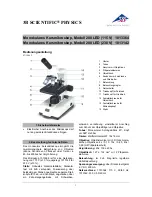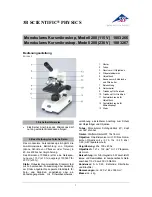
3B SCIENTIFIC
®
PHYSICS
1
Binokulares Polarisationsmikroskop 1012404
Bedienungsanleitung
08/13 ALF
1 Okular
2 Tubus
3 Analysator
4 Revolver mit Objektiven
5 Präparateklemmen
6 Objekttisch
7 Kondensorregler
8 Kondensor mit Irisblende Filter-
halter und Polarisator
9 Beleuchtung
10 Beleuchtungsregler
11 Netzschalter
12 Feststellschraube für Polarisator
13 Grob- und Feintrieb mit Feststell-
bremse
14 Feststellschraube für Objekttisch
15 Stativ
16 Feststellschraube für Mikroskop-
kopf
1. Sicherheitshinweise
•
Elektrischer Anschluss des Mikroskops darf
nur an geerdeten Steckdosen erfolgen.
Vorsicht! Die Lampe erhitzt sich während des
Gebrauchs. Verbrennungsgefahr!
•
Während und nach Gebrauch des Mikro-
skops Lampe nicht berühren.
2. Beschreibung, technische Daten
Das binokulare Polarisationsmikroskop ermög-
licht die zweidimensionale Betrachtung von Ob-
jekten (dünne Schnitte von Gesteinsproben,
Pflanzen- oder Tieren) in 40- bis 400-facher
Vergrößerung in polarisiertem Licht.
Stativ:
Robustes Ganzmetallstativ, Stativarm fest
mit Fuß verbunden; Fokussierung über beidseitig
am Stativ angebrachte koaxiale Stellknöpfe für
Fein- und Grobtrieb mit Kugellager und Feststell-
bremse; einstellbarer Anschlag zum Schutz der
Objektträger und Objektive.
Tubus:
Binokularer Schrägeinblick 30°, Kopf um
360° drehbar, Augenabstand zwischen 54 mm
und 75 mm einstellbar, Dioptrienausgleich ±5 für
beide Okulare
Polarisationseinrichtung:
Polarisator mit Skala
und Analysator in Tubus einschiebbar
Okular:
Weitfeld-Okularpaar WF 10x 18 mm
Objektive:
Invers geneigter Objektivrevolver mit
3 DIN achromatischen Objektiven 4x / 0,10, 10x
/ 0,25, 40x / 0,65
Vergrößerung:
40x, 100x, 400x
Objekttisch:
Runder Objekttisch Ø 120 mm, um
360° drehbar, Gradeinteilung mit Nonius und 2
Präparateklemmen
Beleuchtung:
Im Fuß integrierte, regelbare
Halogen-Leuchte 6 V, 20 W; universale Span-
nungsversorgung 85 V bis 265 V, 50/60 Hz Hz
Kondensor:
Abbe Kondensor N.A.1,25 mit Iris-
blende, fokussierbar über ein Zahnstangengetriebe
Abmessungen:
ca. 240 x 190 x 425 mm³
Masse:
ca. 6 kg


































